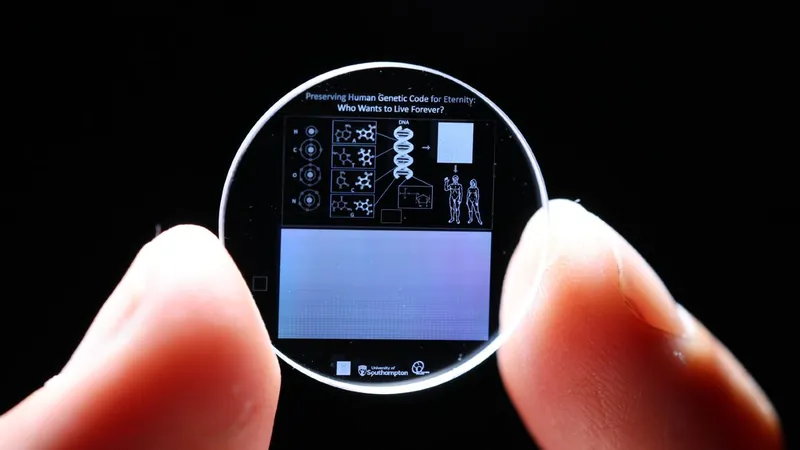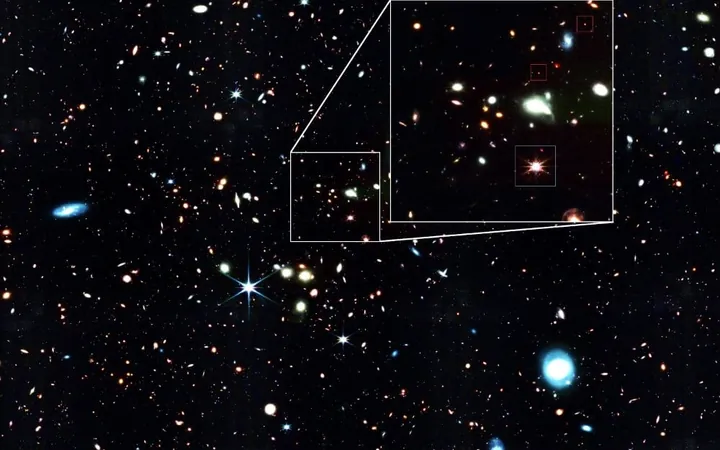
Scientists Store Human Genome in '5D Memory Crystal' That Could Last Beyond the Universe’s End
2024-09-25
Author: Wei
Introduction
In a groundbreaking achievement, scientists have successfully encoded humanity's genetic blueprint into a revolutionary "5D memory crystal," a technology that promises to preserve vital information for billions of years—potentially enduring even until the universe's final moments.
Development of the 5D Memory Crystal
Developed by researchers at the University of Southampton, this cutting-edge coin-sized crystal utilizes a synthetic material that emulates the exceptional qualities of fused quartz, a highly stable form of glass composed of nearly pure silica. Since its inception in 2014, this memory crystal has been recognized by Guinness World Records as the most durable data storage medium on the planet.
Stability and Resilience
Unlike conventional data storage systems that deteriorate over time, the 5D memory crystal boasts an impressive stability, with predictions suggesting it could remain intact at room temperature for an astounding 300 quintillion years. Even under extreme heat, up to 190 degrees Celsius (374 degrees Fahrenheit), it is expected to survive for approximately 13.8 billion years, which aligns with the current age of our universe. This implies that the crystal may outlive Earth, set to meet its demise in about 5 billion years due to the sun's expansion.
The crystal displays remarkable resilience, capable of withstanding temperatures reaching 1,800 degrees Fahrenheit (1,000 degrees Celsius) and enduring pressures equivalent to 10 tons per square centimeter, approximately the weight of two African elephants. Additionally, the crystals can resist prolonged exposure to cosmic radiation, making them well-suited for potential space travel or preservation in extraterrestrial environments.
Data Encoding Process
To encode data within the crystal, scientists employ advanced laser technology that inscribes information onto millions of minuscule nodes arranged in a five-dimensional matrix. This matrix incorporates two optical dimensions and three spatial coordinates, enhancing the storage capacity dramatically. These crystals can hold a staggering 360 terabytes of data—more than 5,000 times that of a standard iPhone.
The Human Genome Project
In this particular project, the researchers encoded the full human genome, consisting of about 3 billion letters represented by the four nucleotide bases: adenine (A), cytosine (C), guanine (G), and thymine (T). The completed crystal will be sealed in the Memory of Mankind collection, strategically located within an ancient salt mine in Hallstatt, Germany. The hope is that this DNA time capsule could serve as a blueprint for reviving humanity long after our species has vanished from existence, whether that be thousands, millions, or even billions of years into the future.
Critiques and Considerations
While the current technology does not allow for the revival of an extinct species from a single genome alone, the team believes a future advanced civilization—either evolutionarily linked to humans or entirely from another world—might possess the tools and knowledge to make such revival possible.
Moreover, they have included visual representations of nucleotide structures and essential atomic configurations—such as those of carbon, oxygen, and nitrogen—aiming to illuminate the purpose of the crystal for any potential discoverers in the distant future.
However, skepticism exists among some experts regarding the feasibility of using this crystal for future resurrection, with critics noting that interpreting its contents may be challenging. "I can barely connect my 10-year-old iPod and listen to what I listened to back then," commented Thomas Heinis, a DNA storage specialist from Imperial College London.
Implications of the Technology
Despite these doubts, the implications of this extraordinary technology extend beyond just a genetic time capsule. Peter Kazansky, the project lead and a professor in optoelectronics, pointed out that this innovation could herald a new era of genomic conservation, offering a means to establish a lasting repository of genetic information—potentially enabling the restoration of complex organisms like plants and animals should future scientific advancements allow.
Conclusion
As humanity contemplates its place within the universe, this remarkable creation serves as a testament to our quest for permanence in an impermanent world. The idea of preserving human genes for eons evokes both wonder and concern, leaving us to ponder what the future might hold when we are no longer here.


 Brasil (PT)
Brasil (PT)
 Canada (EN)
Canada (EN)
 Chile (ES)
Chile (ES)
 Česko (CS)
Česko (CS)
 대한민국 (KO)
대한민국 (KO)
 España (ES)
España (ES)
 France (FR)
France (FR)
 Hong Kong (EN)
Hong Kong (EN)
 Italia (IT)
Italia (IT)
 日本 (JA)
日本 (JA)
 Magyarország (HU)
Magyarország (HU)
 Norge (NO)
Norge (NO)
 Polska (PL)
Polska (PL)
 Schweiz (DE)
Schweiz (DE)
 Singapore (EN)
Singapore (EN)
 Sverige (SV)
Sverige (SV)
 Suomi (FI)
Suomi (FI)
 Türkiye (TR)
Türkiye (TR)
 الإمارات العربية المتحدة (AR)
الإمارات العربية المتحدة (AR)